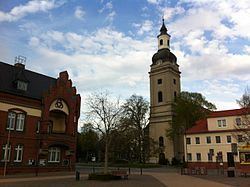Time zone CET/CEST (UTC+1/+2) Area 224.2 km² Local time Sunday 2:15 AM | Elevation 49 m (161 ft) Postal codes 39307 Population 15,014 (31 Dec 2015) Postal code 39307 | |
 | ||
Weather -1°C, Wind E at 3 km/h, 100% Humidity | ||
Genthin ( [ɡɛnˈtiːn]) is a town in Jerichower Land district, in Saxony-Anhalt, Germany.
Contents
Map of Genthin, Germany
Geography
It is situated east of the Elbe river on the Elbe-Havel Canal, approx. 50 km (31 mi) northeast of Magdeburg and 27 km (17 mi) west of Brandenburg. The municipal area comprises the incorporated villages of Gladau, Paplitz, Schopsdorf, and Tucheim.
Genthin was the administrative seat of the Verwaltungsgemeinschaft ("collective municipality") Elbe-Stremme-Fiener until its merger into the newly established Jerichow municipality in 2010.
History
Genthin Castle was first mentioned in a 1144 deed, it was the residence of the Plotho noble family who then served as ministeriales of the Archbishops of Magdeburg. The surrounding settlement was documented as a town in 1459, its citizens were vested with market rights in 1539.
When the last administrator of the Magdeburg archbishopric, Duke Augustus of Saxe-Weissenfels, died in 1680, Genthin with the Duchy of Magdeburg fell to the Electors of Brandenburg. The Baroque Trinity parish church was erected from 1707 to 1722.
The town's economy was decisively promoted by the building of the Elbe–Havel Canal from 1743 onwards and the opening of the Berlin–Magdeburg railway line in 1846. A detergent factory was opened in 1921 by Henkel.
On the night of 21–22 December 1939, at least 186 (according to other sources: 278) people were killed in a train crash at Genthin station, making it one of the most deadliest railway accidents in Germany. A monument to the victims was erected in the town. In 1943 a subcamp of Ravensbrück concentration camp was built in Genthin for about 1,000 female prisoners and forced labourers. After World War II, Genthin was part of the Soviet occupation zone.
Twin towns
Magdeburg is twinned with:
